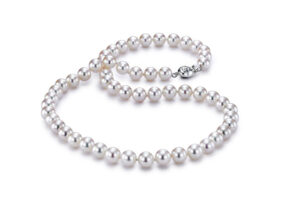By Jennifer Heebner, Editor in Chief
Joshua Israileff was stunned at the prices of Akoya Pearls when he visited the International Jewellery Tokyo fair in mid-January: costs per strand were about what he would charge his own clients.
“Prices were 30–80% more for AAA goods,” says one of the owners of ASBA USA.
In fact, after two days of walking the fair, he realized that one of the first vendors he shopped and turned down—“I wanted her to waive 10%,” he recollects—was actually offering fair prices. “She was right, and I was wrong.”
This sticker shock continues, with many dealers saying more price hikes are en route. Assael’s Peggy Grosz expects her main Akoya Pearl supplier to deliver new pricing later this month, after the rest of the Japanese Akoya Pearl auctions (these have been occurring between January and April) are complete.
“We’ll have to raise some prices and eat some of the costs,” says Grosz about her high-end brand’s Akoya Pearl programs in retailers like Neiman Marcus.
And with the Couture show on the horizon (the trade-only jewelry fair takes place June 1–4 in Las Vegas and is a major buying event for U.S. merchants), Grosz is already bracing for some difficult conversations.
“How do you sit in front of a retailer and tell them prices have gone up 60–80%? We’ll work on lower margins, but it’s a shame when Pearl demand is so high.”

Price Drivers
A confluence of ongoing factors has created this tough toll for Akoya Pearl lovers.
For starters, Asian demand for Pearls is voracious, with industry insiders dishing that some producers sell directly to specific firms in lieu of sending goods to auction.
Aziz Basalely of Eliko Pearl returned from the Hong Kong International Jewellery fair over the weekend, with fresh images of jam-packed Japanese Pearl sections in his mind.
“People were shoving and grabbing merchandise—it was extremely crowded to even navigate the aisles,” he says. “Japanese suppliers sold every single strand last year. Now there’s virtually no decent supply of Akoyas in the market, even from the biggest producers.”
Jonathan Louttit of Imperial Pearl witnessed the frenzy firsthand, too. “The Japanese Pearl section was frightening—just unbelievable how many people were there,” he says. “Dealers had sold out of most of what they had in the first two days of the show.”

Photo by Eliko Pearl
After Asian demand, there’s Japanese Akoya pearl mortality and fewer growers to consider.
Yuichi Nakamura of PJ Nakamura International, a Pearl wholesaler in Japan who is in frequent contact with many farmers, recently confided to AGTA about prices and problems.
“First-class quality Japanese Akoya Pearl prices are up 80% year over year, while second-class quality is up 60% over last year,” he says. “Farmers are struggling with the high mortality rate of baby Akoya oysters—since 2019, a virus has been killing them. Many countermeasures have been conducted, but still one thing is for sure—no increase in pearl production is predicted. In 1990, there were over 2,000 farmers in Japan, but a price drop for the product made this number decline to 600 growers in 30 years.”
For sure, diminished production is affecting prices. According to Nakamura, Japanese Akoya Pearl production in 1990 totaled 67 tons; last year there were only 9.5 tons. Less product on the market naturally means higher prices, which started escalating two years ago.
“Japanese Akoya prices have tripled in two years—isn’t that crazy?” he observes. “But from the farmer’s point of view, the prices of Akoyas were undervalued for the past 30 years.”
Limited Availability
Even when dealers—and their clients—can swallow the higher Japanese Akoya prices, getting product in hand is a whole other mountain to climb.
“Even if clients say yes to the price, now you have to go and get the product—many don’t even have it to give to me!” exclaims Louttit.
Meanwhile, the Vietnamese-grown Akoya pearl industry can’t offer much relief. “That product is pretty much great for the 2–5 mm size Pearl,” maintains Fran Mastoloni of Mastoloni Pearls.
But when it comes to the larger sizes and the top-quality goods, most dealers still look to Japan to fill those orders.
Grosz sent her Pearl buyer to Hong Kong in search of new stock but saw nothing in their preferred quality at the show. Assael has a robust inventory, but replacement costs are a concern. “What kind of prices do you want to put on them?” Grosz adds.
Basalely, too, is waiting on word from Japan. After Japanese Akoya auctions end, it takes months to process the new harvests. “There won’t be anything fresh in the market until May, so it remains to be seen what those new prices will be,” he says.
In the meantime, Akoya Pearls continue to sell well with minimal consumer pushback on costs.
Israileff just finished a 92-inch endless Japanese Akoya Pearl strand for one store, while his business partner brother Nicolai fields text requests from a D.C. merchant for three pairs of 9.5 to 10 mm Akoya Pearl studs. ASBA’s current keystone price is $3,000 apiece, though in the past those earrings would have retailed for at least half as much. Still, buyers aren’t complaining, perhaps due to Pearls’ ongoing high profile in fashion and media.
“There’s still a lot of great promotion for Pearls happening,” he says.
This is proprietary content for AGTA and may not be reproduced.
